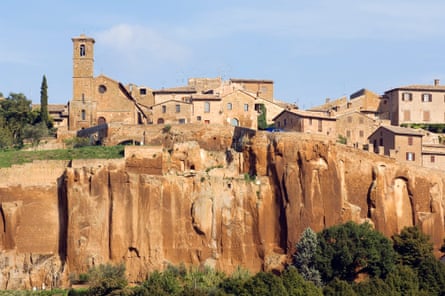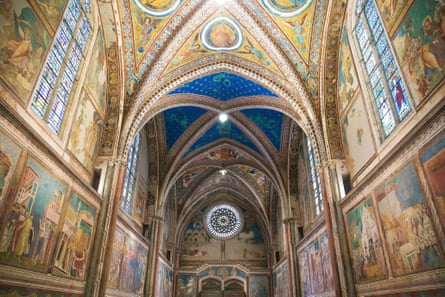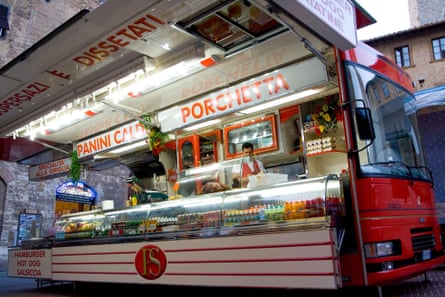Finding your own patch of peace – and finding it on the cheap – isn’t always easy in Italy. But fortunately for holidaymakers, Umbria isn’t much like the rest of the country. The landlocked region between Tuscany, Le Marche and Lazio has art treasures to match anywhere on the peninsula - in Assisi and Perugia above all. Yet it never does a Portofino on your pocket.
The Guardian’s product and service reviews are independent and are in no way influenced by any advertiser or commercial initiative. We will earn a commission from the retailer if you buy something through an affiliate link. Learn more.
For most of the year, medieval hill-towns such as Todi and Spoleto hum along to the quiet rhythms of tradition. A “busy spot” here wouldn’t even register on Capri. Even its plant life has a proletarian feel: Umbria’s kindly hills are more often planted with olive trees than with grape vines.
Another plus is that, as Italian regions go, Umbria is a manageable size: it takes about an hour to get from Perugia to Terni along the SS3 bis; about half that to drive from Perugia to Spello on the only other fast road, the east–west E75 superstrada. Pick the right base – choosing accommodation fairly close to one of these roads – and you can see most of the region’s highlights in a short space of time. You can’t achieve that in neighbouring Tuscany.
Southern Umbria: the great outdoors

Umbria’s big attraction is the stuff that’s missing. No Umbrian city makes it into Italy’s largest 25. In fact, fewer than a million people live in the region. Vast landscapes are almost empty, smothered in woodland or olive groves, and punctuated by hills that roll their way to a hazy horizon. All that silence is crisscrossed by a network of hiking and biking trails, most of which are well-managed.
Inaugurated in 2013, the Grand Tour Rando recreates the southern Umbria of the 18th- and 19th-century grand tourists, as a series of long-distance cycling routes. Rides of 200km-300km start from Marmore Falls – described by Lord Byron as a “matchless cataract. Horribly beautiful!” You can cover as much or as little as you like, passing Narni and Amelia, the weird fossilised trees at Dunarobba and the ruins of the Roman Carsulae along the way. The website includes route maps and an affordable accommodation booking service. The only upfront fee is €10 for the circuit’s Road Book. For other cycling itineraries, try Bike in Umbria (bikeinumbria.it).
A network of marked paths follow the wanderings of Saint Francis. Italy’s patron saint spent much of his life amid this bucolic scenery. You will find maps, suggested routes for all abilities, and details on points of interest at Umbria Francesco’s Ways. A new six-day trail also connects the birthplaces of early Franciscan martyrs, in the hills west of Terni. See camminoprotomartiri.it for maps, background and a list of budget accommodation along the route.
There are bite-size walks in southern Umbria, too. From central Spoleto, you can roam to the ilex woods of Monteluco and back via the Ponte delle Torri, a 90m-high aqueduct that spans a 200m ravine outside the town. (Goethe was a fan. He thought the aqueduct was Roman; it’s actually medieval.)
Local legend claims Michelangelo liked to stroll around here, past the ancient stone carvings of San Pietro church. It is practically impossible to get lost, and you can complete the loop in a couple of hours.
Spoleto was the final stop for one of the Renaissance’s most notorious painters. Filippo Lippi was a Carmelite friar who fled Tuscany after an affair with a novice nun called Lucrezia Buti. She started by modelling as the Virgin (for one of his Madonna and Child paintings) and ended by bearing him a son, Filippino, who also became a painter. Lippi died midway through painting the apse frescoes in Spoleto cathedral (free to enter).
Orvieto

Orvieto is visible for miles in every direction, seeming to sprout from a wall of volcanic rock. The site has been inhabited since the Etruscan era at least, when it was “Velzna”, one of Etruria’s most powerful cities. It is a place whose character shifts after dark. The streets around the “Golden Lily of Cathedrals” are a united nations of visitors during the day. But most are day-trippers: when the tour buses leave, Orvieto takes on a local vibe, and it’s this, as much as the marquee sights, that rewards a longer stay.
It is good value, too. A handful of Umbrian tourist towns offer biglietti cumulativi, combined admission tickets for multiple sights. Orvieto’s is the best. The Orvieto Unica card costs €18 and includes the Last Judgment frescoes of the cathedral’s Cappella di San Brizio, Etruscan relics at the Museo Claudio Faina, as well as two more museums, an hour-long tour of caves under the city (see orvietounderground.it), a couple of Etruscan necropoli, a trip down a Renaissance well, up a medieval tower, and a return ride on Orvieto’s funicular. Individually those would cost well over €30. A walking trail around Orvieto’s cliffs, the Anello della Rupe, costs nothing.
Umbrian cooking is heavy on meat and game, as well as big flavours such as truffle and porcini mushrooms. Dishes are more eclectic at Orvieto’s Osteria Numero Uno, where a daily chalkboard menu features the likes of pork fillet with peaches and balsamic vinegar. There’s also a play corner where kids create happy havoc while you linger over a final caffè. It is informal on the eye, serious on the stomach: mains start from around €10. Numero Uno is closed on Mondays, so book at Trattoria del Moro, which has a fine reputation with locals for its traditional cucina orvietana.
Northern Umbria: art for free

Head north to gorge yourself on art, without spending a cent. Almost every Umbrian church – the main exception being Orvieto’s cathedral – is free to enter. And we are not talking bit-part, consolation-prize art either: some of central Italy’s finest paintings decorate the churches of northern Umbria.
In Assisi, the Basilica of San Francesco d’Assisi is a place of pilgrimage for Christians and art historians. Painters who worked in Assisi in the 1200s and 1300s include Cimabue, Pietro Lorenzetti, Simone Martini, and Giotto – the latter’s iconic Story of Saint Francis fresco cycle is in the Gothic Upper Church. It may sound a chore, but if you get there in time for the 6am opening, you may have the Lower Church to yourself for a while, an experience you won’t quickly forget. I loved the brooding atmosphere so much, I did it twice.
Keep following Francis into the hills above Assisi for free admission to the Eremo delle Carceri, the hermitage where he regularly retreated to to contemplate in silence. It gets busy in summer, but you only need drift a short way from the hermitage to find the deserted woodland trails of Monte Subasio. Again, it’s all free, and only three miles east of town.
In nearby Spello, Umbrian painter Pinturicchio – who later added the Vatican and Siena’s cathedral to his CV – decorated the Cappella Baglioni inside the church of Santa Maria Maggiore. Painted around 1500, his three frescoed panels are, in his trademark style, hyperreal and grotesque-laden. The chapel also has an intricate 16th-century majolica floor made in nearby Deruta, now, as then, Umbria’s main centre for ceramics production.
Art in Umbria’s capital, Perugia, is a little trickier to do on the cheap. There is a free exhibition space in the Rocca Paolina – all that remains of a castle Perugians ripped apart when they threw off papal rule in 1860. The Fontana Maggiore, sculpted by the Pisanos in the 1270s, is on open view in Piazza IV Novembre. The city’s best art is inside the Galleria Nazionale dell’Umbria. However, for just €10, you can buy the Perugia Città Museo pass; it gets you, plus a child under 18, into the gallery, as well as four more art sites in Perugia. Even the full price €6.50 is a steal for one of Italy’s premier painting collections – there’s Piero della Francesca, Perugino and a lot more.
Festivals and markets

Umbria has some of Italy’s liveliest festivals. For the most part they are free. As well as the themed festivities, a local saint, a bit of medieval tradition, there’s usually food, perhaps a set meal for €10 or so. Among the best during spring and early summer are Porchettiamo, Bevagna’s Mercato delle Gaite, and Spello’s Infiorate, when the town’s streets are carpeted in petals to mark the feast of Corpus Domini. See grandieventi.regioneumbria.eu for a festival calendar. Even a small sagra (festival) in a local village will give an insight into Umbrian life that you won’t find in a gallery or cathedral — there’s an invaluable sagra survival guide at brigolante.com.
Away from festival season, you can seep into Umbria at a weekly market. Market day is also the time to grab Umbria’s best bargain lunch: the porchetta (herbed pork sold in a roll) vendor is a permanent fixture, and usually charges just a few euros. The markets in Città di Castello (Thursday) and Orvieto (Thursday and Saturday) are worth making tracks for.
Affordable accommodation options in Umbria

Everything in Umbria is generally cheaper than in Tuscany. However, you will struggle to find a bargain in peak periods, including in Assisi over Easter, around Spoleto during its three-week arts festival (June and July), and along the shores of Lake Trasimeno around the Italian summer holiday of ferragosto (15 August).
The best affordable accommodation in Orvieto is Sant’Angelo 42 (Via Sant’Angelo 42, +39 348 775 7136, doubles from €95), where rooms are bright and spacious, in a vaguely modern-rustic style. The place is air-conditioned, and scattered with furniture by local wood artisan Michelangeli. Ask for one of the rooms on the top floor, each of which has a small balcony. Rooms at Ripa Medici B&B (doubles from €65 B&B) have a genteel, antique feel to them, suited to its location down a medieval alleyway on the edge of the centre.
Affordable, good-quality Assisi accommodation is like gold dust. Brigolante (apartments from €400 a week, sleeping two) has well-equipped apartments in a stone farmhouse outside the centre. From November to March, you can stay for two nights or more, otherwise it’s weekly bookings.
Monastery Stays arranges rooms in convents and monasteries, including at Assisi’s Istituto Beata Angelina (twin room €87 B&B), overlooking the Basilica of San Franceso Francis, and the Casa di San Ponziano in Spoleto (doubles from €86 B&B). Everyone is welcome – you don’t need to be the contemplative type – but you do need to accept a curfew that falls between 10pm and midnight.
Real Holidays (020-7359 3938) has a wide Umbria villa portfolio, including at the budget end: Palazzo Guastaldo, an apartment sleeping four set in a fortified hamlet, costs £585 a week in mid-season.
Holiday rental websites HomeAway.co.uk and Holidaylettings.co.uk have Umbrian self-catering properties in every price range. Hostelbookers.com and Hostelworld.com list budget hotels and rural agriturismos, as well as hostels.
Getting there
Ryanair (ryanair.com) flies to Perugia from Stansted from £52 return, and to Ancona (less than two hours’s drive from Spello and Assisi) from £52 return. EasyJet (easyjet.com) flies to Rome (two hours from Perugia) from Bristol, Luton and Gatwick
Further information
Reliable planning information for Umbria is scarce. The official iPad app was last updated in 2011, and guidebook companies have begun to drop the region from update schedules. The most recent is Footprint’s Perugia, Assisi & Southern Umbria, by Julius Honnor (£7.99). On the web, Bellaumbria.net, InOrvieto.it, and the region’s official site, Regioneumbria.eu, have useful advice in English. Though dormant for a while now, there is still good information to mine from Umbriaontheblog.com

Comments (…)
Sign in or create your Guardian account to join the discussion